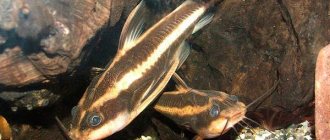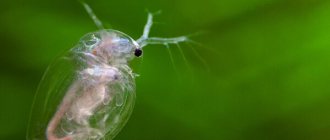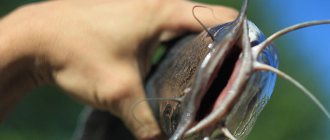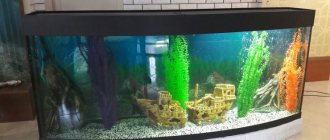The title of representatives of the most extensive order of fish is rightfully held by the perch-like inhabitants of the underwater kingdom. This order, belonging to the class of ray-finned fish, unites approximately forty percent of the species of bony fish. The distribution area of the individuals representing the order includes absolutely all marine bodies of water and most freshwater ones, which means they can be found in all climatic zones of the planet without exception.
Perciform fish are the largest order of ray-finned fish that inhabit all the water bodies of our planet.
General description and characteristics
The Latin name of the order is Persiformes. Its representatives are mostly predators. In terms of color variants, perciformes belong to one of the most diverse orders. The color of a particular individual is directly related to its habitat, or rather, to the climatic region in which it lives. Tropical fish have brighter colors than others. Individuals swimming in reservoirs of northern latitudes have a rather pale and even faded, nondescript color, predominantly in gray-brown tones.
Perciformes come in a variety of colors, but most have a sharp fin on the head or back
Like many fish existing in the modern world, they have a bony backbone. It is usually connected to the skull through a movable attachment to the maxillary apparatus. The head of a perch-like individual is usually “decorated” with spines. The mouth of individuals representing the order is formed by jaws, the functioning of which is carried out according to the so-called grasping method. The fish makes a weak movement forward, freezes for a while, after which it quickly rushes at the chosen victim with the maximum possible speed. This style of attack does not leave the prey the slightest chance of salvation.
Most perciformes have seta-like teeth that are quite small in size. But some varieties have large fangs. The skin of these fish is covered with scales, most often of the ctenoid type. Like all fish belonging to the bony class, representatives of this order have gill covers.
The swim bladder is in no way connected with the intestines, and in some varieties it is completely absent. The anus is separated from the genitourinary.
Presence of fins and their location
One of the main features of perciformes is their fins. They are usually equipped with peculiar spines - some fin rays have the shape of undivided sharp spines. Most individuals have two dorsal fins.
The adipose fin is completely absent. If there are ventral ones, they consist of no more than six rays. They are located mainly under the chest and occasionally in front of them - on the throat. The pectoral fins are placed either obliquely or perpendicular to the long axis of the body.
The fins are equipped with spines and decorate the head, back and chest of fish
Sizes of individuals
In terms of size, perciform fish of different species are very different from each other. The smallest representatives are the gobies Schindleria brevipingus, living near the Australian east coast. The inhabitants of the underwater world of this species are among the smallest fish on the planet. Their weight is only one milligram, and their body length reaches:
- in males - 7.7 mm;
- in females - 8.4 mm.
The largest perch-like individuals are blue marlins (Atlantic and Indo-Pacific). They can grow up to five meters in length and weigh almost a ton. Also among the largest representatives are:
- swordfish;
- black marlin;
- common tuna.
These individuals are capable of reaching a length of 4.5 meters.
https://youtube.com/watch?v=tvLNpnLXz-g
But still, according to the traditional understanding of the order, small-sized individuals predominate among perciformes. Over a third of all species included in this order have a body length within ten centimeters. Large representatives of perciformes, whose sizes are equal to or exceed one meter, account for less than three percent of the total number of species.
Most representatives of this species are small in size
Animals
Order Perciformes
Perciformes are the most extensive order of fish, including at least 150 families, grouped into 20-21 suborders. This order apparently contains over 6,000 species of fish, distributed throughout the most diverse bodies of water on our planet. Perciformes usually have spines on their fins. Pelvic fins, if present, have no more than 6 rays and are usually located under the base of the pectoral fins or in front of them, on the throat. The bases of the pectoral fins are located obliquely or perpendicular to the long axis of the body. No adipose fin. The swim bladder has no connection with the intestines, or it does not exist at all. Within the order Perciformes, suborders are considered.
SUBORDER PERCOIDEI Perciformes are a very diverse suborder. They are characterized by the presence of one well-developed spiny ray in the pelvic fins, well-developed, as a rule, spiny rays in the dorsal and anal fins, the position of the ventral fins under the base of the pectoral fins, rarely in front or slightly behind. This suborder contains about 50 families.
SUBORDER ECHENEOIDEI There is only one family in this suborder.
SUBORDER LABROIDEI Wrabees are coastal marine fish that live mainly in tropical and subtropical waters. They live at shallow depths near coral reefs, among rocks and stones or in algae thickets. The lower pharyngeal bones of representatives of this suborder are fused into a single plate, and the “chewing” pharyngeal teeth are well developed and adapted for grinding solid food. The dorsal fin is always single, with spiny rays in the anterior part. The coloring of the wrasse is very variable and sometimes extremely bright. The wrasses include three families - wrasse, parrotfish and Australian wrasses. Many of these fish have edible and tasty meat, however, without forming mass aggregations, they are used only for local consumption.
SUBORDER TRACHINOIDEI (TRACHINOIDEI) Trachinoid fish have a low, elongated body, usually with a short body and a long, laterally compressed tail. The dorsal fin is either single, long, or divided into a short anterior one and a long posterior one. The anal fin is long, usually without spiny rays, less often with 1-2 spiny rays. The pectoral fins usually have a wide base, the pelvic fins are located in front of them or, less commonly, below them. The mouth is usually large, terminal or oblique, directed upward. Almost all trachinoids are bottom-dwelling fish, a few are bathypelagic, deep-sea. The trachinaceae include 16 families, the most important of which are the hair-toothed, bol-sherotaceae, or opisthognathaceae, bathymasteraceae, dragonetaceae, stargazers and live-swallowers, or chiasmodaceae.
SUBORDER NOTOTENIOIDEI A peculiar group of five closely related families, united in this suborder, lives only in Antarctica and partly in the adjacent waters of the southern hemisphere, being in its distribution the southernmost group of fish in the world. In the shape of the body and fins and in color, many representatives of this group surprisingly resemble either our Far Eastern slingshots (Cottidae) or greenling fish (Hexagrammidae), but the similarity is purely external, since it is not due to more or less close kinship. With a general perch-like type of structure, notothenioid fish are distinguished by the peculiar structure of the skeleton of the pectoral fin (there are only three bones for attaching the fin rays). They all have one pair of nostrils. The lateral line on the body is often represented by three branches, of which the median is usually located only in the back of the body. If the operculum is armed, then spines are usually developed on the opercular bone. There are no sharp spines in the fins. The pelvic fins are in front of the pectoral fins, with one unsegmented and five branched rays. The body is usually covered with scales, less often naked. Almost all nototheniformes are small to medium-sized fish, only a few species reach a meter in length or more. In recent years, some species have acquired commercial importance. In the suborder of nototheniform fishes, slightly more than a hundred species belonging to 34 genera are known. These are predominantly bottom and demersal marine fish, but some of them have secondarily adapted to a pelagic lifestyle, using the rich food resources of open ocean waters. Of the five families of nototheniids, only one family of cheek-horned fish (Bovichthyidae) is characteristic of temperate waters of the southern hemisphere. Other families (Nototheniidae, Harpagiferidae, Bathydraconidae and Chaenichthyidae) are predominantly Antarctic, since they reach their greatest species and genus diversity in the cold waters surrounding Antarctica. In the benthic fauna of the Antarctic, about 3/4 of the species inhabiting it belong to notothenioid fishes, while the few other families known here (rays, parrotfishes, lykodas, sea slugs) are represented by only a few species. It is important to note that almost all species of nototheniformes and the vast majority of their genera are endemic to the Antarctic region1, since they are not found outside of it. Such high endemism is a phenomenon unknown for other large faunal regions of the World Ocean. Antarctica can thus be called the kingdom of nototheniform fish. The nototheniidae include the families of cheek-horned, nototheniaceae, bearded, flat-nosed and white-blooded fish.
SUBORDER BENNIOIDEI Dog-shaped fish have an elongated, eel-like body in some, with long dorsal and anal fins. The pelvic fins usually sit on the throat and contain no more than 5 rays, or none at all. Pectoral fins with a wide base, usually located perpendicular to the long axis of the body. The scales are usually small or absent, the skin is bare with copious mucus secretion. There are many families that belong to the dog-like family; the most important of them are: blenny, catfish, three-feathered, wedge-shaped, elemental, ptilichtidae, butterfish, crooked.
SUBORDER ZOARCOIDEI The only family in the suborder.
SUBORDER ICOSTEOIDEI This suborder also contains a single family.
SUBORDER SCHINDLERIOIDEI And in this suborder there is only one family.
SUBORDER GERTILE (AMMODYTOIDEI) Includes a single family - gerbils.
SUBORDER LYRE-MOIDEI (CALLIONYMOIDEI) Peculiar small fish of this suborder, like gerbils, stay on the sandy bottom, burying themselves in the sand when in danger. There are two families: lyre fish, or minnows, and dragonettes.
SUBORDER GOBIOID (GOBIOIDEI) A distinctive feature of gobiids is the structure of the pelvic fins, in which the rays facing outward are shorter than the rays facing inward. As a rule, the pelvic fins are very close together and even merge with each other, forming a funnel. They are located on the chest. The first dorsal fin is usually small, consisting of weak spiny, more precisely, unbranched rays; occasionally it is absent or connected by a membrane with the second dorsal, which is always present. The suborder Gobiformes contains about a dozen families, of which the most interesting are the firebrands, riacichtaceae, gobies, ribbon gobies, microdesmaceae and mudskippers.
SUBORDER KURTOIDEI Only 2 species belong to this suborder.
SUBORDER SURGICAL (ACANTHUROIDEI) This suborder, which differs from other perciform fish in some skeletal features, contains only three families. All surgeonfishes belong to the coastal marine fish that live in tropical waters, mainly near coral reefs. They have a laterally compressed body, very small scales and weak teeth. A very characteristic feature of this group of fish is the passage of a pelagic stage in individual development, and their peculiar larvae are very different from the adults. Most species of the suborder belong to herbivorous fish.
SUBORDER Hair-tailed fish (TRICHIUROIDEI) Hair-tailed fish are a unique group of predatory marine fish that lead a pelagic lifestyle. All of them have, to one degree or another, an elongated body, a large mouth and powerful fang-shaped teeth. The dorsal fin consists of spiny and soft parts. Representatives of this suborder show quite significant similarities with mackerel-like fish, from which they differ in some anatomical features. The suborder includes two families - gempilov and hair-tailed, which are common in warm seas and oceans around the world.
SUBORDER SCOMBROIDEI This order includes the only family of well-known fish.
SUBORDER Swordfish (XIPHIOIDEI) This suborder includes three families of highly specialized marine fish that lead a pelagic lifestyle and are common mainly in open waters far from the coast. They are characterized by such skeletal features as fusion of the nasal bones into a solid outgrowth (“sword”) or their absence, a smooth surface of the frontal bones, and a small number of vertebrae. The pectoral fins in sword-snouts are located near the lower edge of the body, and the ventral fins are either not developed at all or are represented by a few (from 1 to 3) rays. Fossil remains of representatives of this suborder have been known since Eocene deposits: swordtails have existed for about 60 million years. Some fish belonging to the suborder under consideration reach very large sizes and, along with moonfish (Molidae), are among the largest modern bony fish. All of them have tasty meat and serve as fishing grounds.
STROMATEOIDEI STROMATEOIDEI is a small suborder of perciform fish, comprising 6 families and characterized by the presence of two pouch-shaped pharynx structures equipped with teeth behind the last gill arch (these formations are absent only in the Amarsipidae family). The appearance of representatives of this group is quite diverse, but they all have much in common in the appearance of the head. Blunt, slightly protruding snout. large eyes surrounded by adipose tissue, the upper jaw almost hidden under the preorbital bone - these are the external signs by which stromateoids differ from other fish at first glance. Using an anthropomorphic comparison, we can say that they all have a slightly stupid and somewhat alarmed expression. This suborder includes marine fish that inhabit tropical and temperate waters and are absent only in the coldest regions of the Arctic and high Antarctica. As a rule, they lead a pelagic lifestyle, but there are also benthic species in this group. It is very typical for stromateoid fry to live together with jellyfish, siphonophores or pelagic tunicates, under which they hide from predators. Sometimes fish even settle in the gastrovascular cavity of jellyfish or inside a colony of pyrosome fireworms. Such cohabitation not only provides the fry with good shelter, but also provides them with a table: here they have the opportunity to feed on the leftover food of their “masters,” and in some cases they also bite off parts of the body of the patrons themselves. In the course of adapting to this way of life, these fish have developed a special mechanism of protection against the poisonous stinging cells of jellyfish and siphons. The fry of stromateoides are much less susceptible to the toxic substances of their “hosts” than other fish, although they do not have complete immunity to them. In addition, their body is often covered with a thick mucous membrane. As adults, representatives of this suborder no longer need such protection, but many of them continue to “maintain an interest” in soft-bodied invertebrates, using them exclusively as food.
SUBORDER CREEPERS (ANABANTOIDEI) Crawler-like fish are remarkable primarily for their adaptability to breathing atmospheric air. Their gill cavity is expanded upward. This special expansion houses an additional respiratory organ in the form of lamellar outgrowths covered with mucous epithelium and abundantly supplied with blood vessels. The labyrinth-shaped curved plates that form this organ extend from the first gill arch (the “labyrinth organ” of slider fish), or it has a slightly different structure (in snakehead fish). The body and head of creeper fish are covered with ctenoid scales. There is one dorsal fin with spiny and soft parts. The caudal fin is rounded. The pelvic fins are located on the chest, below the pectoral fins. The swim bladder is bifurcated at the back and continues into the caudal part of the body. Creepers are common in Africa, South and Southeast Asia. The suborder Creepers includes three families: Creepers, Pikeheads and Snakeheads.
SUBORDER PROMOBILE (MASTACEMBELOIDEI) Fish of this suborder have an eel-like body shape, but the presence of spines in the fins, the structure of the skeleton and other features indicate that they belong to the perciformes. Proboscis snouts are common in the fresh waters of tropical Africa and Southeast Asia.
Species of individuals
The representatives of this vast order include more than one and a half hundred families, classified into two dozen suborders. Thus, the number of species of perciform fish in total exceeds ten thousand. Many of these fish are considered commercial and important.
Individuals of perciformes are capable of fully existing in natural objects with both salt water and fresh water, therefore this order includes both marine fish and freshwater fish. Among the representatives of the order Perciformes, the most widespread are:
- bulls;
- ruffs;
- perches;
- mackerel;
- horse mackerel;
- zander;
- tunas.
The tuna we know is a type of perciform fish.
Of these fish, the most striking example of the ubiquitous habitat of perciformes is pike perch.
Several species of pike perch live in the Caspian and Black Seas, some species live in rivers, and there are also so-called semi-anadromous individuals that migrate from river reservoirs to the seas. Therefore, debates about the classification of pike perch continue to this day - some consider it a marine fish of the order Perciformes, others consider it a freshwater representative of the order.
"ORDER PERCIFORMES" in books
Order Insectivores
From the book Mammals by the author
Order Insectivores This order includes hedgehogs, moles, and shrews. These are small animals with a small brain, the hemispheres of which do not have grooves or convolutions. The teeth are poorly differentiated. Most insectivores have an elongated muzzle with a small proboscis.
Order Chiroptera
From the book Mammals by the author Vladislav Ivanovich Sivoglazov
Order Chiroptera This order includes bats and fruit bats. The only group of mammals capable of long-term active flight. The forelimbs are transformed into wings. They are formed by a thin elastic leathery flight membrane, which is stretched between
Order Lagomorpha
From the book Mammals by the author Vladislav Ivanovich Sivoglazov
Order Lagomorpha These are small and medium-sized mammals. They have two pairs of incisors in the upper jaw, located one after the other so that behind the large front ones there is a second pair of small and short ones. There is only one pair of incisors in the lower jaw. There are no fangs, and incisors
Squad Rodents
From the book Mammals by Vladislav Ivanovich Sivoglazov
Detachment Rodents The detachment unites different species of squirrels, beavers, mice, voles, rats and many others. They are distinguished by a number of features. One of them is the peculiar structure of the teeth, adapted to feeding on solid plant foods (branches of trees and shrubs, seeds,
Squad Predatory
From the book Mammals by the author Vladislav Ivanovich Sivoglazov
Order Carnivores The order unites mammals that are quite diverse in appearance. However, they are characterized by a number of common features. Most feed mainly on vertebrates, a few are omnivores. All carnivores have small incisors, large conical fangs and
Order Pinnipeds
From the book Mammals by the author Sivoglazov Vladislav Ivanovich
Order Pinnipeds Pinnipeds are marine mammals that have maintained a connection with land, where they rest, breed and molt. Most live in the coastal zone, and only a few species live in the open sea. All of them, as aquatic animals, have a peculiar appearance:
Order Cetaceans
From the book Mammals by Vladislav Ivanovich Sivoglazov
Order Cetaceans This order unites mammals whose entire life is spent in water. Due to their aquatic lifestyle, their body acquired a torpedo-shaped, well-streamlined shape, the forelimbs were turned into fins, and their hind limbs disappeared. Tail
author
Order Perciformes, or spiny-finned (Perciformes)
From the book Animal World of Dagestan by the author Shakhmardanov Ziyaudin Abdulganievich
Order Perciformes (Perciformes) Contains 150 families, united in 16 suborders. It has about 6000 species. The family Percidae has over 100 species, 5 species live in the Caspian Sea, which are also found in the reservoirs of the Dagestan coast of the Middle
SQUAD
From the book Partisan Nights by Walach Stanislav
SQUAD Together with “Bolek” I began to form the first partisan detachment. I started with my closest comrades. It so happened that they were mostly my neighbors. “Albina” - Stanislav Lovec, “Staszeka” - Stanislav Ptasinski and “Povalu” - Tadeusz
Squad B
From the book Coinage by Lawrence Thomas Edward
2. Squad B I woke up feeling light. I'll like it here. Today sunlight brightens everything. The delivery boy and I leisurely ate a standard breakfast, and I helped him sweep several rooms and corridors of the headquarters by half past seven, before the first officers showed up. I
16. Detachment No. 731
From the book The Last Emperor of China.
Pu And author Usov Viktor Nikolaevich 16. Detachment No. 731 Based on a secret order received from Tokyo, in 1936 the secret Detachment No. 731 was created and stationed in Harbin. However, later it was moved outside the crowded Harbin, where there were quite a lot of unnecessary “ eyes", in the person of spies and intelligence officers
Order Perciformes
From the book Aquarium Fish Farming by the author Ilyin Mikhail Nikolaevich
Order Perciformes The order Perciformes unites a large number of species of marine and freshwater fish, widespread throughout the globe. The detachment includes about 20 suborders. Here we will consider representatives of four suborders of freshwater
Perciformes
From the book Great Soviet Encyclopedia (OK) by TSB
I. SQUAD
From the book String and Chandelier by Krapivin Vladislav
The title of representatives of the most extensive order of fish is rightfully held by the perch-like inhabitants of the underwater kingdom. This order, belonging to the class of ray-finned fish, unites approximately forty percent of the species of bony fish. The distribution area of the individuals representing the order includes absolutely all marine bodies of water and most freshwater ones, which means they can be found in all climatic zones of the planet without exception.
Perciform fish are the largest order of ray-finned fish that inhabit all the water bodies of our planet.
Classification and suborders
The scientific classification of the order is currently being actively discussed by scientists. Ichthyological specialists intend to revise the taxonomy and “raise” some suborders, transferring them from constituent units to independent ones. It is still unknown which varieties these changes will affect. Today, representatives of perciformes include fish from the following suborders:
- eelpouts;
- gobiform;
- hair-tailed;
- wrasses;
- icosteoid;
- curtus-shaped;
- lyre-shaped;
- swordtails;
- nototheniformes;
- perciformes;
- gerbiloids;
- slider-shaped;
- adhesive;
- mackerel;
- dog-shaped;
- stromateoides;
- trachinoid;
- surgical;
- proboscis snout-shaped;
- Schindleriiformes.
Such diversity only strengthens and confirms the title of the largest order of modern fish, which is assigned to perciformes.











